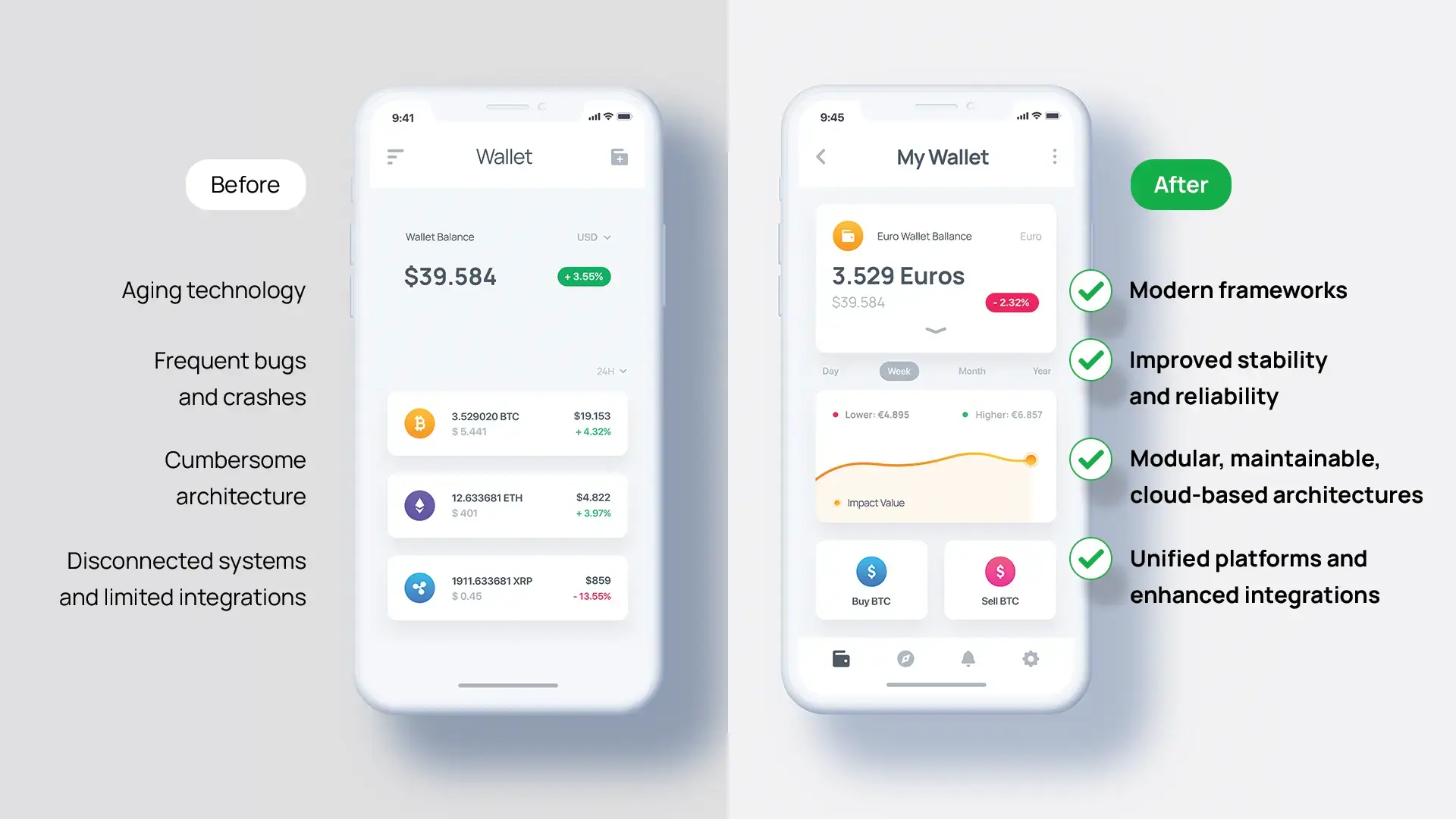As we look towards 2025 and beyond, the financial services landscape is set to undergo significant digital transformation driven by innovation, customer-centric approaches, and new compliance frameworks.
Hence, in this comprehensive overview, we’ll delve into the top 7 fintech trends poised to reshape the industry. We’ll provide expert insights and actionable strategies to navigate the future confidently and make informed decisions.
1. The continued rise of Embedded Finance

Source
Embedded finance, the integration of financial services into non-financial platforms, is transforming the financial landscape. This approach allows users to access financial services directly within the apps they use daily, such as:
- eCommerce platforms
- Travel or fitness apps
- Ride-sharing apps
And many more. The goal? To create a seamless and intuitive user experience. How does it work? It’s simple.
- Take, for instance, a ride-sharing app that offers in-app insurance or payment options, eliminating the need for users to switch to a separate banking app.
- Or consider the simple and intuitive checkout process of your favorite retail brand partnering with fintech companies to offer credit for buy-now-pay-later (BNPL) payments.
This fintech trend has already made a significant impact, being projected to grow by more than €100 billion in Europe by the end of 2030, according to McKinsey.
Essentially, embedded finance solutions leverage the available user data on non-financial platforms, to provide personalized financial services, boosting customer experience, engagement, retention, and revenue, all while making financial services more accessible and integrated into everyday experiences.
2. The expansion of Open Banking

Source
Open banking allows secure data sharing between banks, fintechs, and third-party providers through APIs. In the UK, the number of open banking users already hit eight million, up from five million in January 2022.
This approach gives consumers more ownership of their data, allowing them to share it with authorized third-party providers and thus facilitate access to personalized services within apps they already use.
The open banking trend capitalizes on consumers who prioritize simplicity and availability, posing a great opportunity for fintech companies that are more digitally agile than traditional incumbent banks to meet such market demands.
In Europe, regulatory frameworks are a key driver:
- The PSD2 directive mandates that banks open their payment services and customer data to third-party providers.
- Additionally, EU's revised Payment Services Directive, PSD3, aims to enhance open banking by combating payment fraud, improving consumer rights, and promoting equal access to payment systems. Industry leaders support the ambitious goals, with the directive expected to come into effect in 2026.
- The development of new products like budgeting tools, investment platforms, and alternative credit scoring models.
- More financial inclusion for end consumers who gain access to enhanced financial services, through innovative fintech startups.
- Improved cooperation between traditional banks and fintechs, leveraging each other’s strengths.
3. The proliferation of NeoBanks and the evolving role of Traditional Banks

Source
Neobanks, or digital-only banks, have truly disrupted the traditional banking landscape. These banks operate solely online and are able to offer a wide range of financial services without any physical branches.
Neobanks appeal to modern consumers who prioritize convenience and simplicity. Moreover, the market segment of neobanks is the largest within fintech, with the European market reaching US$1,462.3 billion.
Popular neobanks include Revolut, Chime, Nubank, and more — all of which operate entirely through online platforms, allowing digital onboarding via smartphone. They offer services like:
|
|
As digitalization continues to advance, neobanks are growing into competitive alternatives to traditional banks. That’s because neobanks are unencumbered by legacy systems, they provide intuitive interfaces and often have more competitive fees and interest rates.
Consequently, banks will likely go through digital transformations to integrate new technologies, develop their own digital banking apps, and partner with fintechs to stay competitive. Their edge? More financial stability.
Did you know that Zitec has been driving cost-effective, reliable, and secure digital transformation in European fintechs for the past 20+ years? Learn more about Zitec here.
4. The growth of Decentralized Finance (DeFi)

Source
DeFi helps create more transparent, efficient, and resilient financial systems by removing third parties and centralized financial institutions and central bank digital currencies from financial transactions and empowering peer-to-peer transactions.
Decentralized Finance is projected to grow at a CAGR of 42.2% between 2022 and 2028 in Europe, promoting the application of blockchain technology beyond cryptocurrencies to areas such as:
- Digital identity verification processes
- Transactions such as loans, trading, and cross-border payments without a third-party
While still facing security, regulatory, and market volatility challenges, decentralized finance is becoming a pivotal component of the future financial ecosystem, as anyone with an internet connection can access DeFi platforms without geographic restrictions.
Some key innovative concepts driving its growth include:
- Interoperability — boosts liquidity and allows assets to move freely across ecosystems without intermediaries, reducing transaction costs.
- Decentralized Autonomous Organizations (DAOs) — allow stakeholders to participate directly in decision-making processes, democratizing governance.
- Decentralized Exchanges (DEXs) — facilitate peer-to-peer trading of cryptocurrencies without intermediaries.
- The distributed ledger technology — the very technology that allows users to complete digital transactions independently, without relying on a central authority (e..g blockchain).
5. The growing importance of Customer Experience and the rise of the Superapps

Source
Nowadays, financial companies prioritize customer experiences more than ever in their struggle to remain competitive. The focus falls on providing premium UX/UI and mobile-first designs, seamless onboarding, and real-time feedback to meet the demand for friction-free, secure financial services.
As delivering exceptional customer experiences becomes the norm, new and improved platforms continue to evolve and spread to the global market, including superapps. In fact, such apps will likely become the standard for delivering financial and lifestyle services in the future, just as we can observe through the example of WeChat, the popular Chinese app.
Superapps are platforms that integrate multiple services into a single, unified experience. From payments and investments to insurance and lifestyle offerings, everything is in one place.
Established fintech players like PayPal, Revolut, and even companies from other industries, like X (former Twitter), are slowly moving towards the superapp model:
- PayPal, for instance, has expanded its offerings to include savings accounts, credit, and investment services, all to create a one-stop-shop financial ecosystem.
- Revolut is also broadening its service portfolio, integrating financial management, trading, and even insurance into its platform.
6. The Hyper-Personalization trend
As players in the fintech sector are vying for growing customer bases, consumer-centric financial products and services are taking center stage. Using advanced data analytics, machine learning (ML), and artificial intelligence (AI), the focus falls on improving the user experience, and that implies personalizing each interaction. How exactly?
- First comes the data. Using big data analytics, fintechs can gather and analyze vast amounts of user data, including transaction history, browsing activity, and device usage patterns, all of which the consumer agrees to share.
- Then comes the customization. With insights at hand, the development of tailored financial products such as personalized investment portfolios, customized loan offers, and bespoke insurance plans comes to life.
- Finally, customer engagement is key. Hyper-personalization in action manifests through bespoke products and behavioral nudges (e.g., through trigger-based workflows or chatbots) that guide users toward specific financial decisions. Think of automated savings suggestions, spending alerts, or gamification elements.
So, why aren't 94% of banks providing the level of personalized experiences customers want?
Providing real-time insights, recommendations tailored to unique financial situations, and integrating data from multiple channels to ensure consistency is a hurdle. Throw in the responsibility of compliance with the regulatory requirements of financial institutions, the challenge of data security, and balancing tech investment costs, and there it is — the drawback.
7. The Gen-AI & ML Spectacular Advancements
Analyst Estimates: Provider and Consumer Interest in Generative AI Applications in Financial Services over a 3-year horizon
Source
Implementing AI into financial companies' operations will lead to a root-and-branch transformation of the financial services industry.
More than a fintech trend, artificial intelligence continues to evolve and play an increasingly significant role in enhancing personalization, fraud detection, big data analytics, digital wealth management, financial health platforms, customer support, and more. Let’s explore some of these AI applications below.
Enhanced Fraud Detection
AI-powered fraud detection is a top application, yet a double-edged sword in fintech. Artificial intelligence algorithms can sift through massive volumes of transaction data to identify unusual patterns and potentially fraudulent activities.
Alternatively, machine learning models detect anomalies and flag suspicious transactions, helping with tasks like detecting fake IDs, investigating transactions, and onboarding customers.
On the flip side, generative AI is also expected to be a top fintech challenge. AI technology can significantly increase fraud risks in banking by making fake content like deepfakes easier to create and harder to detect.
Therefore, banks must invest in AI and advanced technologies to prevent these sophisticated frauds, which could result in losses of up to $40 billion by 2027 in the USA.
Customer Service Automation
Source
Leading institutions in customer service have reached advanced levels of AI maturity, using the technology for proactive, personalized engagement. At the most advanced stage, companies handle over 95% of service interactions via AI and digital channels. This involves:
- Deploying chatbots
- Dynamic interactive voice response (IVR)
- AI-assisted support on social media
For instance, DBS, a leading Asian bank, has gone through a deliberate AI-driven digital transformation to improve customer operations, resulting in an additional economic value of SGD 180 million (approx. USD 135 million), with SGD 150 million from revenue growth and SGD 30 million from cost savings and productivity gains.
Our take? AI does not replace human agents but enhances their capabilities. AI systems anticipate customer needs, flagging issues such as higher-than-usual credit card bills or suggesting payment plans. But it’s up to humans to make sure the message is well-received, and users act on it with targeted, personalized interventions.
Why not join 300+ companies already transforming their operations with Zitec?Position your fintech for a confident and innovative future. Reach out. Whenever you’re ready. |
Other Trends to Watch Out for:
The rise of Central Bank Digital Currencies (CBDC) and the adoption of digital currencies
Central Bank Digital Currencies (CBDCs) are digital versions of traditional currencies issued by central banks. Unlike cryptocurrencies, CBDCs are centralized and regulated, aiming to improve efficiency and security and to remove the need for multiple intermediaries. One example of a CBDC is the Digital Euro, an initiative of the European Central Bank.
The COVID-19 pandemic accelerated the shift to digital payments, reducing cash use. In response, 87 countries—over 90% of global GDP—are exploring CBDCs, with nine already launching their own.
The Environmental, Social, and Governance (ESG) Integration for sustainable finance
ESG (Environmental, Social, and Governance) integration represents a shift towards responsible investing. The aim is to balance economic growth with sustainability instead of compromising on one over the other.
Clearly, ESG investing drives companies to adopt sustainable practices. However, its benefits go beyond its green facet – ESG integration can help identify potential risks that traditional financial analysis might overlook and even provide better equity returns.
The rise of on-demand-pay
On-demand pay, also known as earned wage access (EWA), is transforming how employees get paid. How does it work? It’s simple. Fintech solutions like mobile apps allow workers to log in, view their earnings, and withdraw funds as needed.
Many employees now expect immediate access to their earnings, allowing them to access their earned wages as they receive them, rather than waiting for the traditional bi-weekly or monthly payroll cycles.
The increased availability of financial services for SMEs
Long overdue, offering improved financial services for SMEs is a must. As traditional banks often hesitate to lend to small businesses like startup fintech companies, innovative financial ventures discovered a vast, underserved, profitable market in SMEs.
Here are just some of the ways fintechs can redefine the availability of financial services for SMEs:
- Fintechs use their digital leverage to simplify and expedite alternative lending and credit solutions. By simplifying the loan application process, digital-native financial apps reduce the time and paperwork associated with traditional banks.
- Crowdfunding through platforms such as Seedrs and Crowdcube allows SMEs to raise capital from a broad base of investors by offering equity stakes. Hence, fintechs democratize access to investment for small businesses.
- Invoice financing is another remarkable application. Platforms such as MarketInvoice allow SMEs to borrow against outstanding invoices, improving cash flow without taking on traditional debt.
Join Forces with Leading Digital Transformation Partners in Fintech
The financial services industry is undergoing a major shift driven by AI, tech advancements, new customer demands, and emerging regulatory frameworks – and that’s not a bad thing, assuming you’re prepared to face it.
Given the upcoming fintech trends such as embedded finance, open banking, hyper-personalization, and AI-driven financial services, the industry’s future looks bright and promising.
Still, successfully integrating these technologies requires careful planning. To navigate this landscape and achieve sustainable growth, partnering with a trusted digital transformation expert like Zitec can make all the difference.






